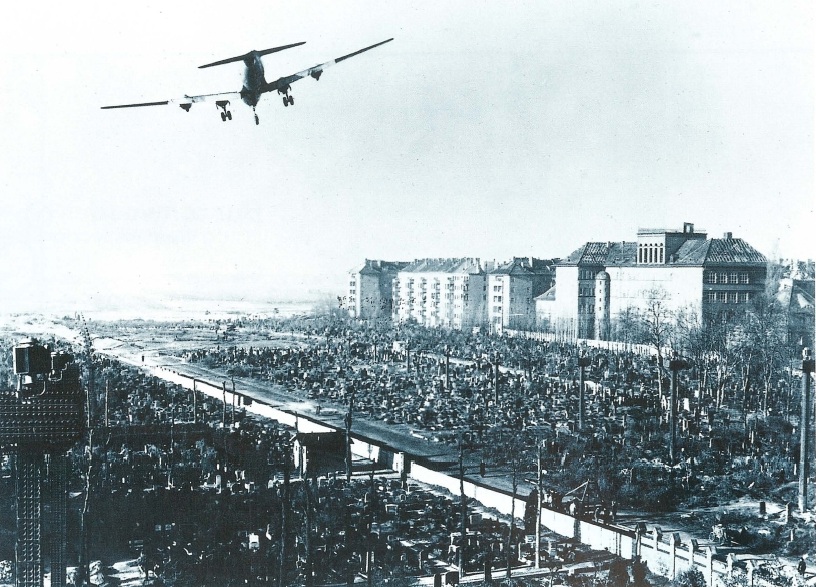
16 April 1949: During the Berlin Airlift, airplanes delivered a record 12,941 tons (11,740 metric tons) of coal—equivalent to 600 rail carloads—to the blockaded city during a 24-hour period. This required 1,383 flights.
© 2015, Bryan R. Swopes

16 April 1949: During the Berlin Airlift, airplanes delivered a record 12,941 tons (11,740 metric tons) of coal—equivalent to 600 rail carloads—to the blockaded city during a 24-hour period. This required 1,383 flights.
© 2015, Bryan R. Swopes
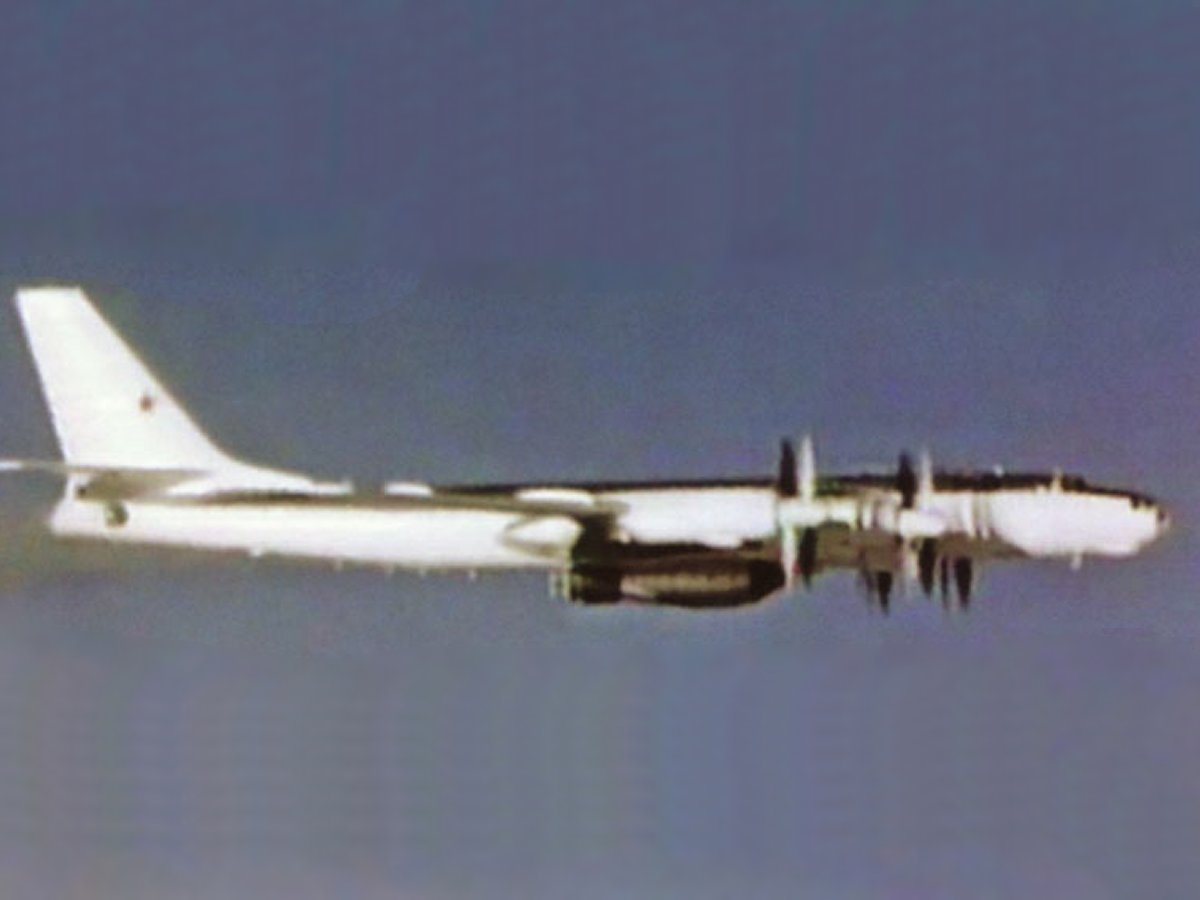
30 October 1961: At 9:30 a.m., specially modified Tupolev Tu-95V “Bear A” bomber, No. 5800302, under the command of Major Andrey Ergorovich Durnovtsev of the 409th Heavy Bomber Air Regiment, departed Olenegorsk Air Base, 92 kilometers (57 miles) south of Murmansk, at 9:30 a.m. The bomber carried a nine-man crew, including navigator Major Ivan Nikoforovich Mite.
The Tu-95 was accompanied by a Tupolev Tu-16 instrumentation ship (No. 3709), under the command of Colonel Vladimir Fedorovich Martynenko. Some sources say that the two bombers were escorted by a flight of fully-armed fighters.
Major Durnovtsev’s mission was to carry out the Soviet Union’s 130th nuclear weapons test. The Tu-95 carried a single RDS-220, a three-stage radiation-implosion thermonuclear bomb. It was 8 meters (26.25 feet) long, with a diameter of 2.1 meters (6.89 feet), and weighed approximately 27,000 kilograms (59,525 pounds). The bomb was variously known as “Big Ivan” or “Tsar Bomba” (King of Bombs).
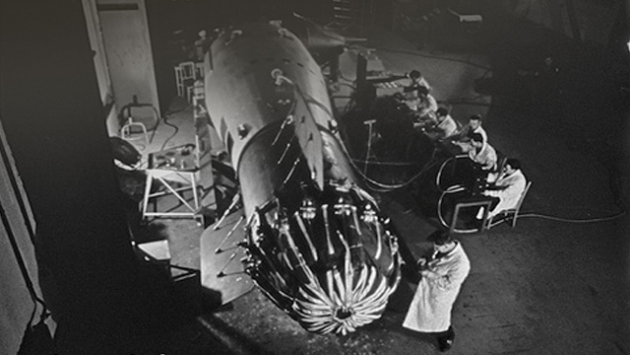
The Tu-95 dropped the RDS-220 from an altitude of 10,500 meters (34,449 feet) over the D-II test range, 15 kilometers (9 miles) north of the Mityushikha Strait on Novaya Zemlya. The bomb was retarded by parachute to allow the Bear time to escape the blast effects. After falling for 3 minutes, 8 seconds, at 11:33 a.m., the bomb detonated 4,000 meters (13,123 feet) above the surface of Novaya Zemlya. A bright flash of light lasted for 30 seconds and finally faded away after 70 seconds.
45 seconds after detonation, the nuclear cloud reached a height of 30 kilometers (19 miles), then spread outward, reaching a maximum diameter of 95 kilometers (59 miles).
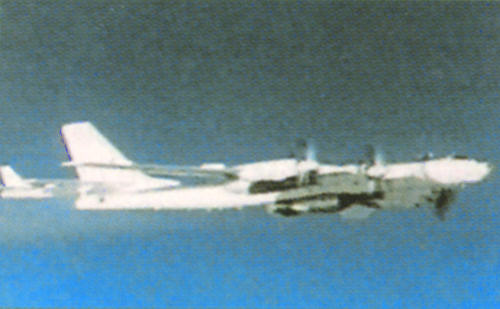
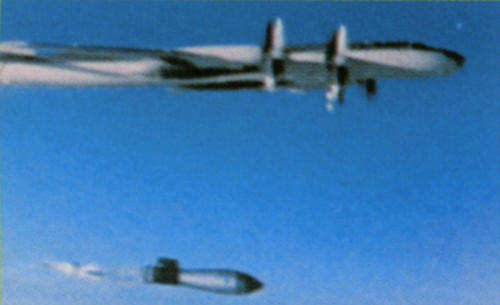

Major Durnovtsev’s Tu-95 was approximately 39 kilometers (24 miles) away for “ground zero” at the time of the explosion. As it continued to fly away from the blast, the shock waves finally caught up to bomber at a distance of 115 kilometers (71 miles), 8 minutes, 20 seconds after they had released the bomb.
At the same time, a secret United States Air Force Boeing JKC-135A Stratotanker instrumentation aircraft, Speed Light Bravo, 55-3127, had flown closer to ground zero to gather data about the air burst. It was so close that its special anti-radiation paint was scorched. (55-3127 was later converted to the NKC-135A airborne laboratory configuration to support the Limited Test Ban Treaty of 1963. It was returned to tanker configuration in the 1980s. Later, 55-3127 served as a test bed aircraft for the Aeronautical Systems Division at Wright-Patterson It was retired to Davis-Monthan Air Force Base in 1992.)
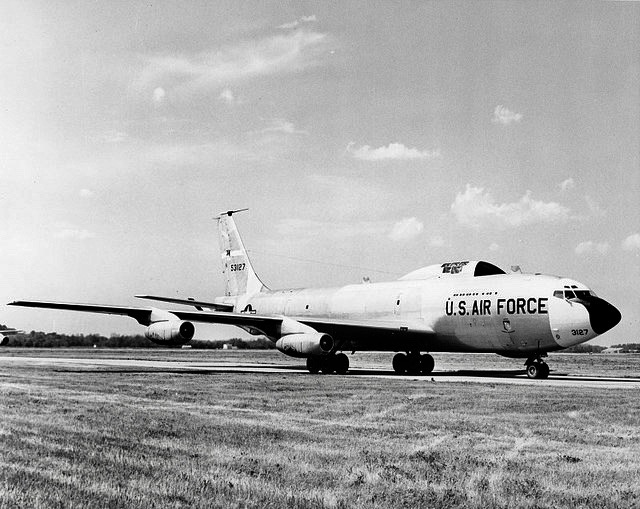
After the nuclear explosion data was analyzed by the Foreign Weapons Evaluation Panel (the “Bethe Panel”) the RDS-220 yield was estimated at 57 megatons. This was the largest nuclear weapon detonation in history. It was also the “cleanest,” with 97% of the energy yield produced by fusion. Relative to the size of the explosion, very little fallout was produced.

All buildings in the town of Severny, 55 kilometers (34.2 miles) from Ground Zero, were destroyed. Wooden buildings as far as 200 kilometers (124 miles) were destroyed or heavily damaged.
A visible shock wave in the air was seen at a distance of 700 kilometers (435 miles). The shock wave from the explosion traveled around the world three times.
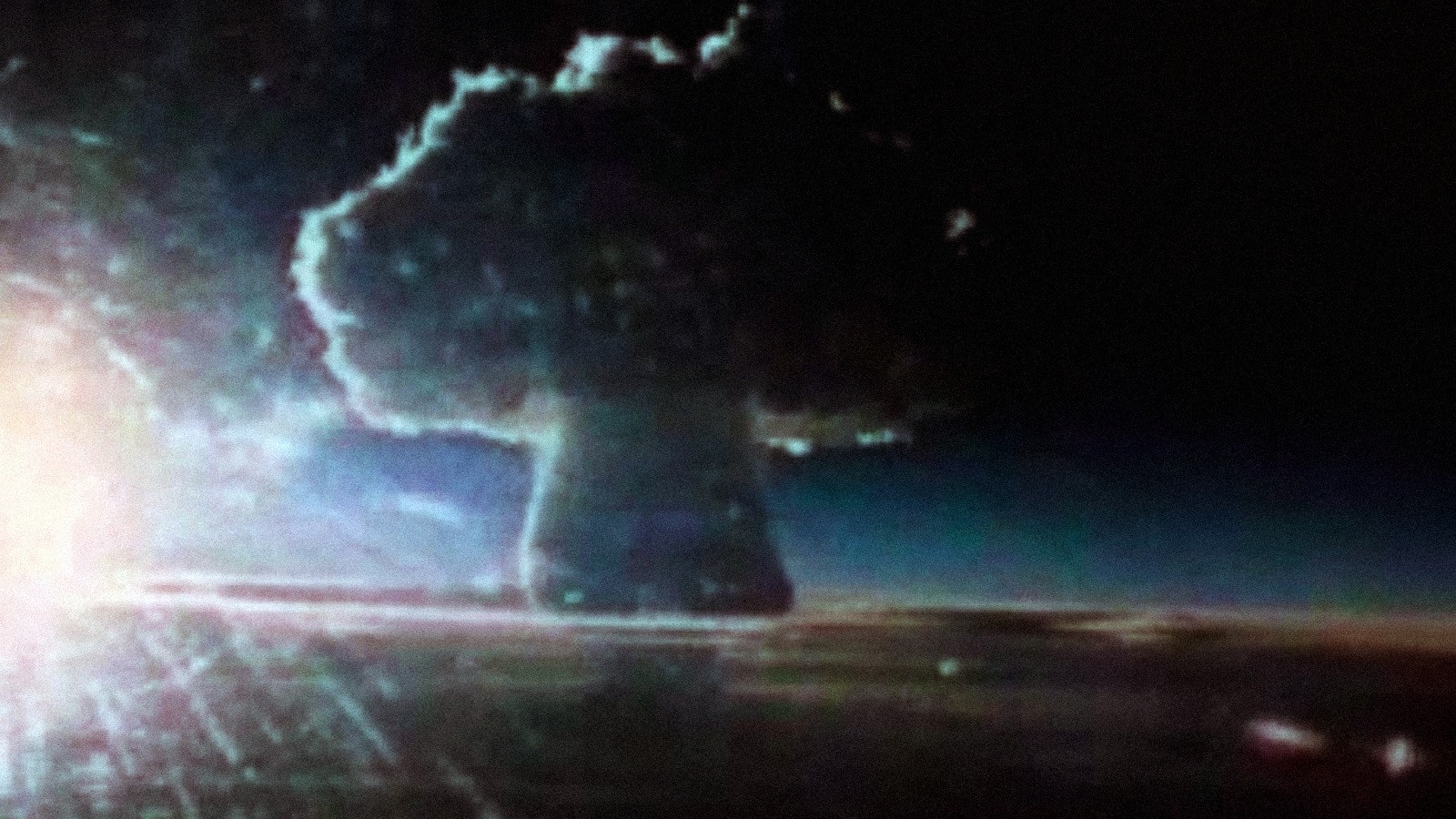
Following the test, Major Durnovtsev was promoted to the rank of Lieutenant Colonel and named Hero of the Soviet Union.
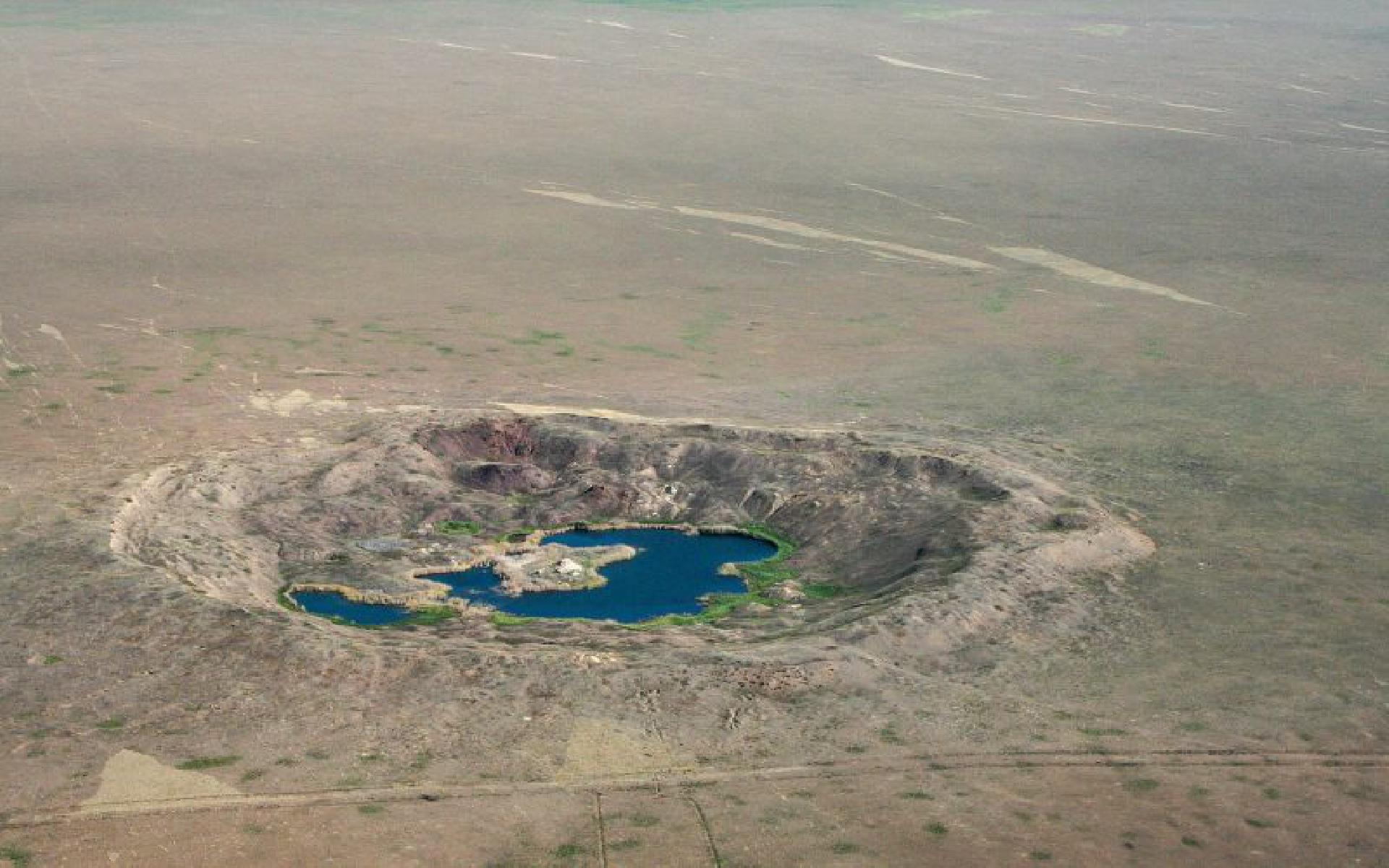
Bear No. 5800302 was ordered in 1955 and completed in 1956. The Tupolev Tu-95 is a long range strategic bomber. It is 151 feet, 6 inches (46.2 meters) long with a wingspan of 164 feet, 5 inches (50.10 meters). The wings are swept at a 35° angle. The bomber is powered by four Kuznetsov NK-12M turboprop engines, producing 14,800 shaft horsepower, each, and turning 8-bladed counter-rotating propellers. It weighs 90,000 kilograms (198,416 pounds) empty, with a maximum takeoff weight of 188,000 kilograms (414,469 pounds). The Bear has a maximum speed of 920 kilometers per hour (572 miles per hour) and an unrefueled range of 15,000 kilometers (9,321 miles). (The Bear A is capable of inflight refueling.) Service ceiling is 13,716 meters (45,000 feet).
Approximately 72 of these aircraft remain in service with the Russian Federation. The current variant is the Tupolev Tu-95MS “Bear H.” Recently, individual bombers have been taken out of service to be modernized by the Beriev Aircraft Company at Taganrog, Russia. The modernized Bear is designated Tu-95MSM. It is expected that 20 Tu-95s will be upgraded.
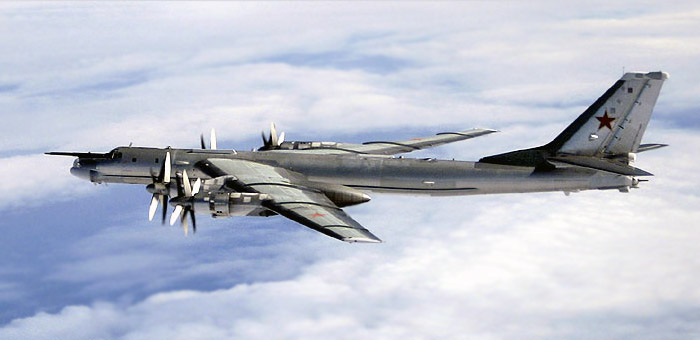
Андрей Егорович Дурновцев (Andrey Ergorovich Durnovtsev) was born 14 January 1923 at Verkhney, a village in the Krasnoyarsk Krai of Siberia. He graduated from high school in 1940.
Durnovtsev was inducted into the Red Army 19 July 1942 and sent to the Irkutsk Military School of Aviation Mechanics, graduating in November 1943. He was promoted to sergeant. Sergeant Durnovtsev request assignment for pilot training, and was sent to the 8th Military Aviation School for initial flight training. In August 1945, he was sent to complete training in long-range bombers at the Engels Military Aviation Pilot School (VAUL). He graduated in 1948.
Lieutenant Durnovtsev next attended the Ryazan Higher Officers’ School, studying the combat application of long-ranger bombers. He was assigned as a pilot with the 330th Bomber Aviation Regiment. Durnovtsev served as an aircraft commander, detachment commnder, then deputy squadron commander.
Lieutenant Colonel Durnovtsev was named Hero of the Soviet Union by decree of the Presidium of the Supreme Soviet, 7 March 1962, “for courage and bravery shown in the development of new military equipment.”
Lieutenant Colonel Drnovtsev retired in 1965. During his military career, he had been awarded the Gold Star Medal, the Order of Lenin, the Order of the Red Star, and the Medal for Military Merit.
Lieutenant Colonel Andrey Ergorovich Durnovtsev, Hero of the Soviet Union, died in Kiev, 24 October 1976, at the age of 53 years.
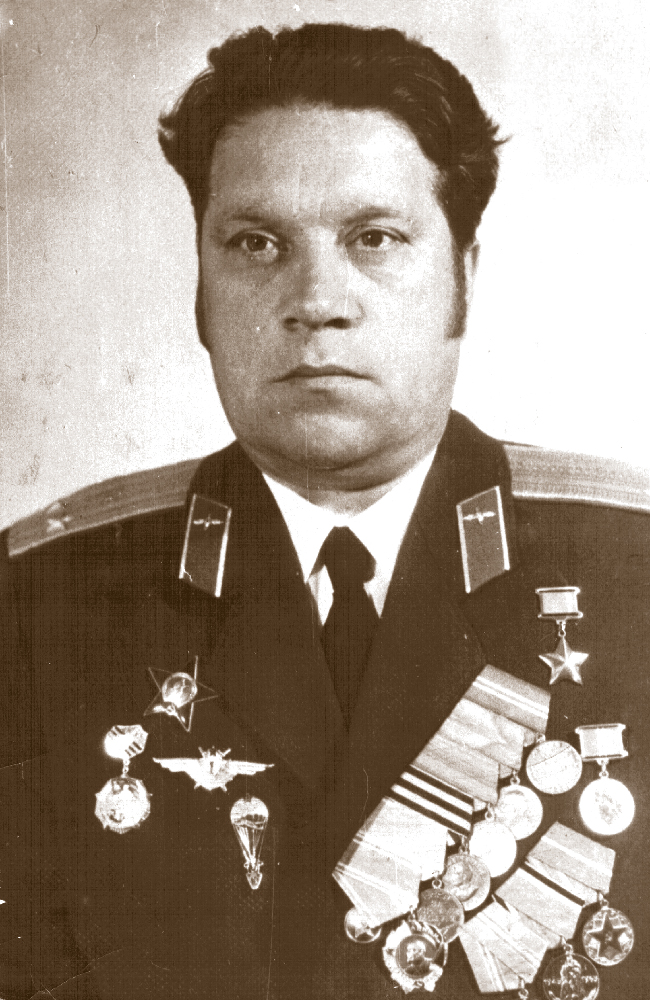
A recently declassified 40-minute video of the test can be viewed on YouTube at:
© 2020, Bryan R. Swopes
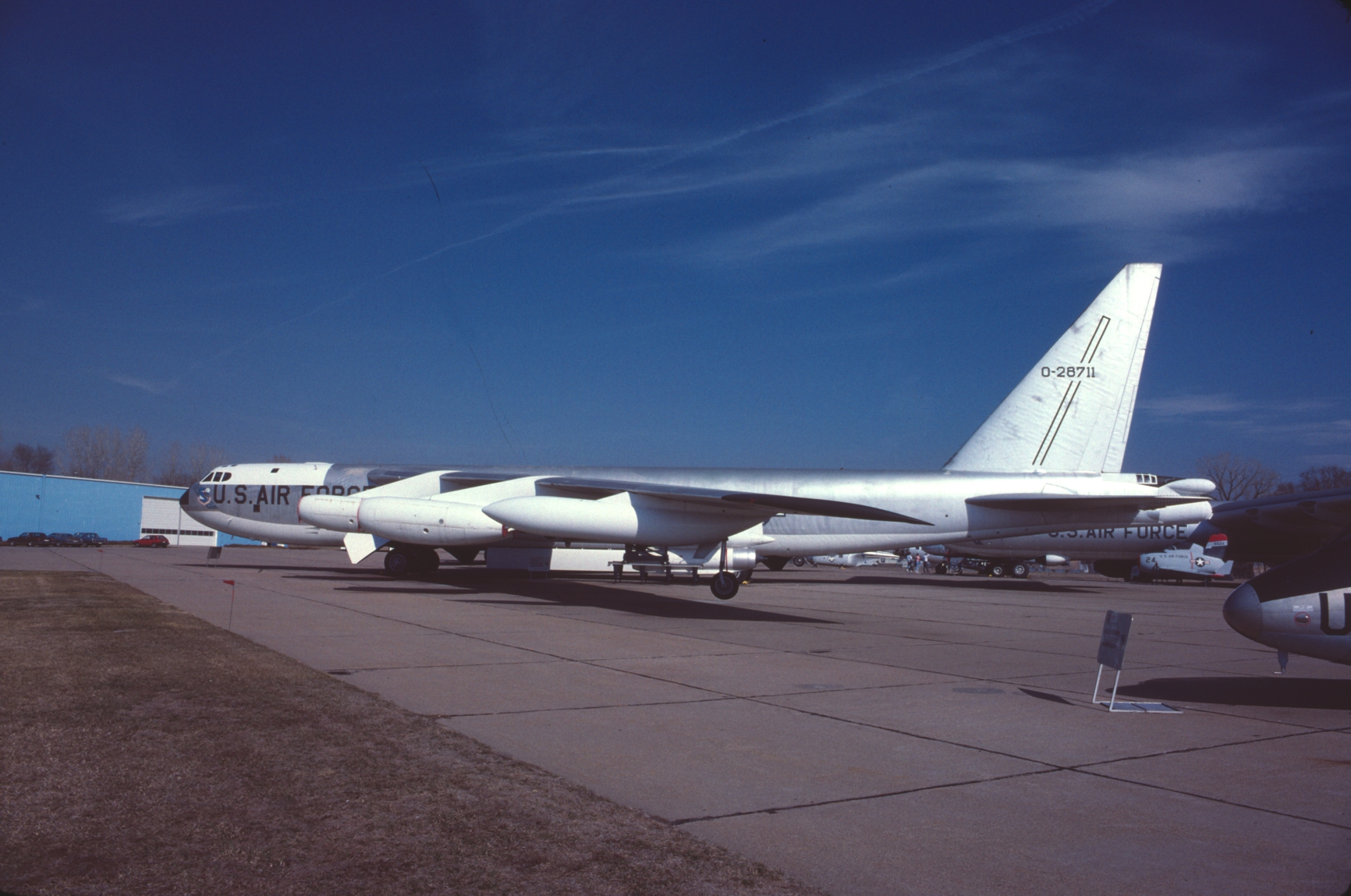
29 September 1965: Ten years after it entered service, the first operational Boeing B-52 Stratofortress, RB-52B-15-BO 52-8711, was retired to the Strategic Aerospace Museum, Offutt Air Force Base, Nebraska.
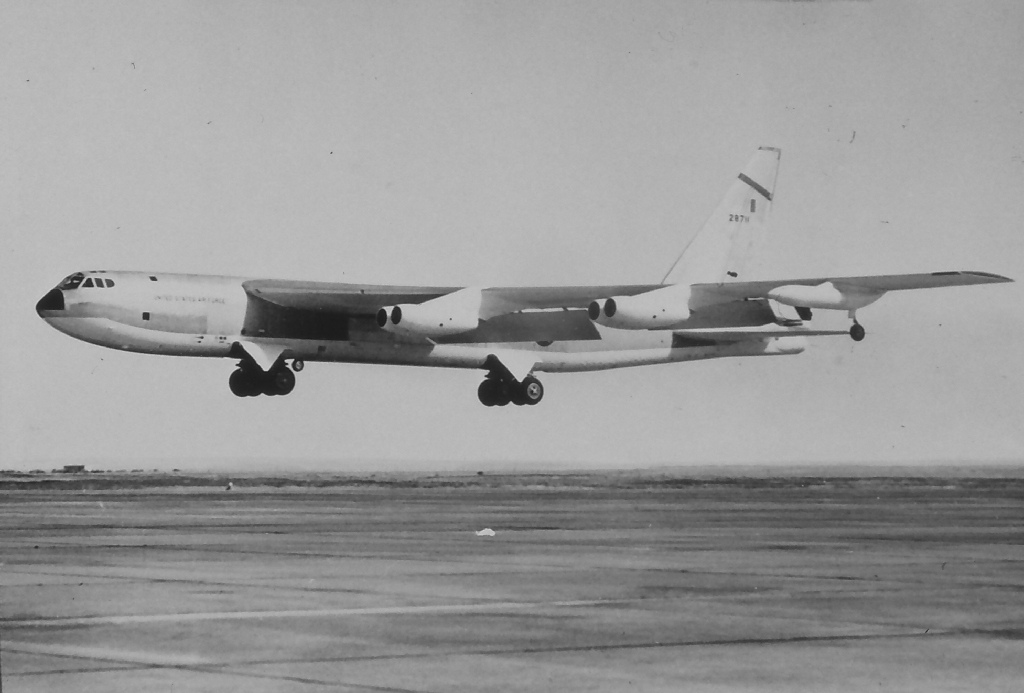
52-8711 had arrived at Castle Air Force Base, California, 29 June 1955, and was assigned to the 93rd Bombardment Wing (Heavy). It later served with the 22nd Bombardment Wing (Heavy) at March Air Force Base, California.
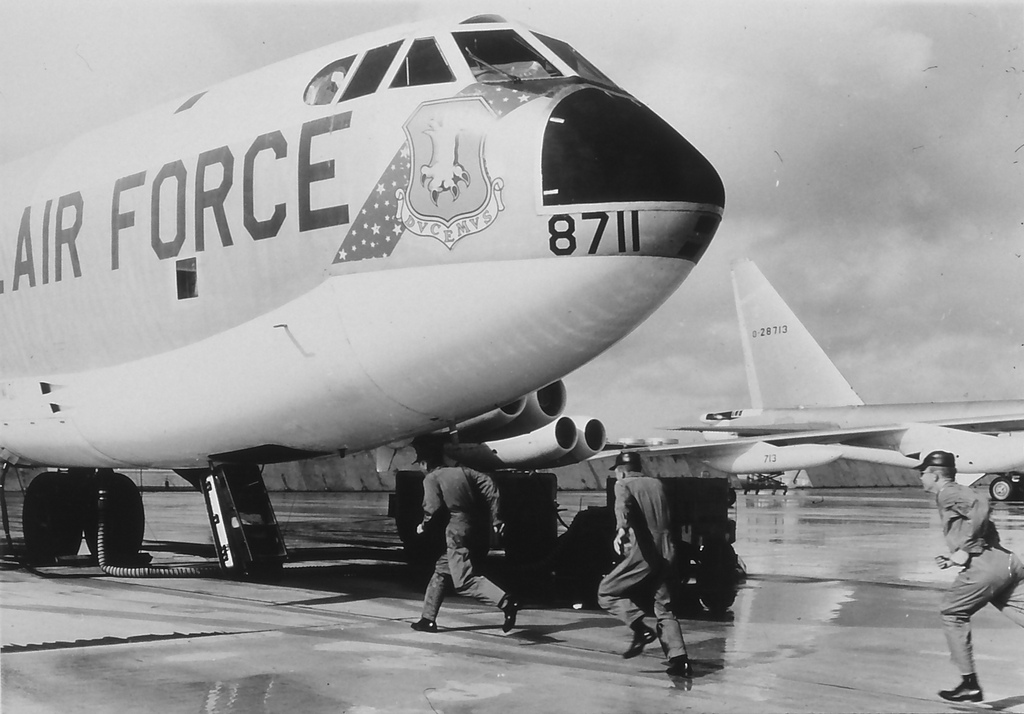
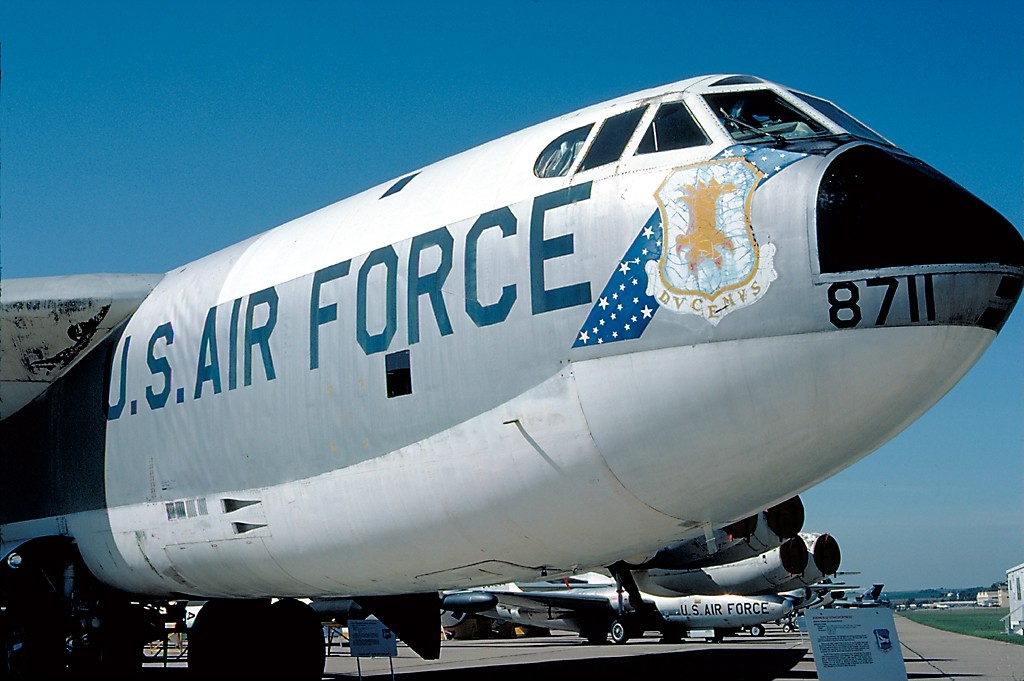
© 2019, Bryan R. Swopes
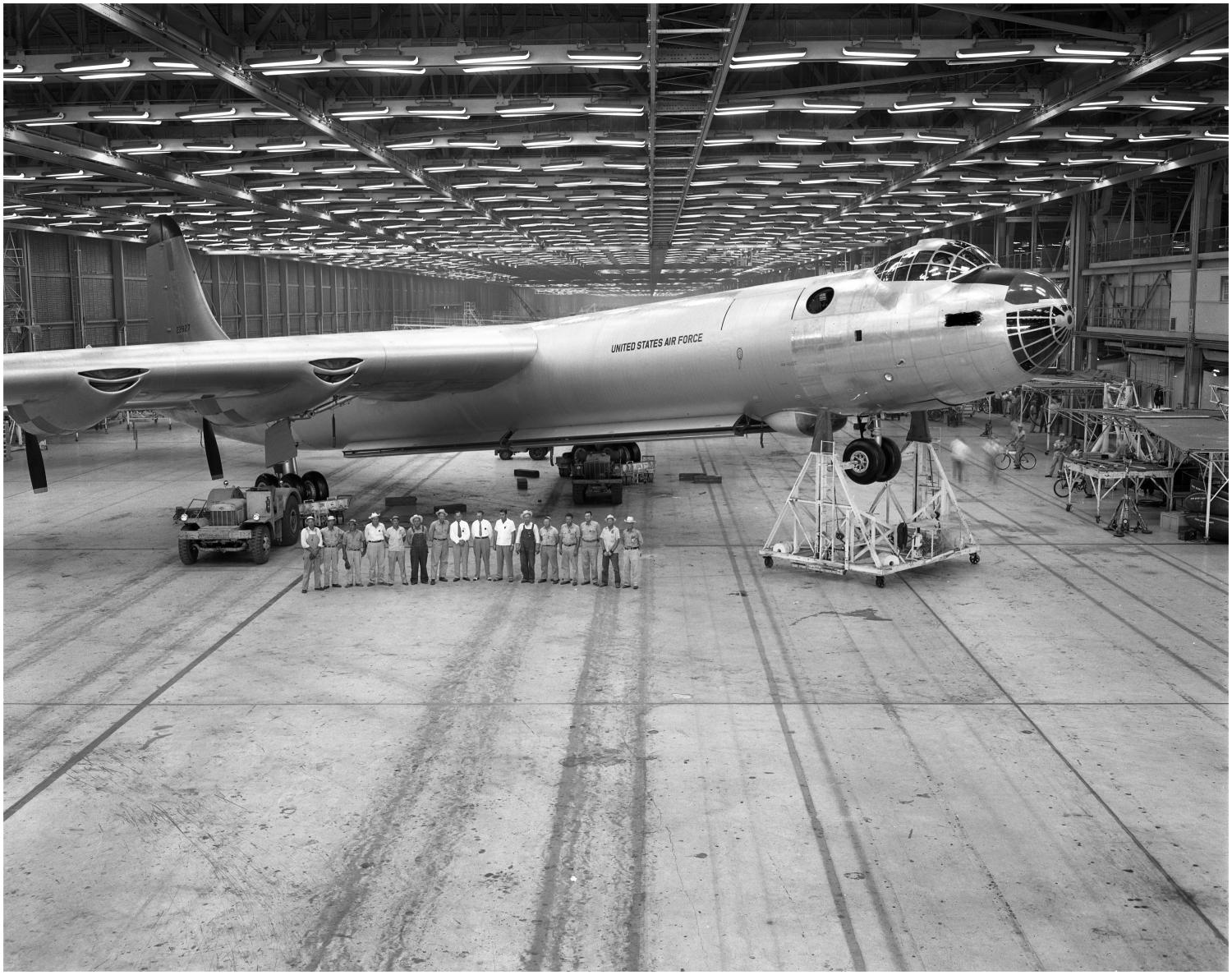
![]() 1 July 1954: The final Convair B-36 Peacemaker, B-36J-10-CF 53-2827, a Featherweight III variant, completed assembly at Convair Division of General Dynamics plant at Fort Worth, Texas. The last B-36 built, this was also the very last of the ten-engine very long range heavy bombers in service. It was retired 12 February 1959, and is now in the collection of the Pima Air and Space Museum, Tucson, Arizona.
1 July 1954: The final Convair B-36 Peacemaker, B-36J-10-CF 53-2827, a Featherweight III variant, completed assembly at Convair Division of General Dynamics plant at Fort Worth, Texas. The last B-36 built, this was also the very last of the ten-engine very long range heavy bombers in service. It was retired 12 February 1959, and is now in the collection of the Pima Air and Space Museum, Tucson, Arizona.
Convair B-36J 52-2827 is one of 14 Featherweight III high altitude variants. It was built without the six retractable defensive gun turrets of the standard B-36, retaining only the two 20 mm autocannons in the tail. This reduced the crew requirement to 13. The bomber is 162.1 feet (49.4 meters) long with a wingspan of 230.0 feet (70.1 meters) and overall height of 46.8 feet (14.3 meters). The wings had 2° dihedral, an angle of incidence of 3° and -2° twist. The wings’ leading edges were swept aft to 15° 5′. The airplane’s total wing area was 4,772 square feet (443.33 square meters). The B-36J III has an empty weight of 166,165 pounds (75,371 kilograms) and its maximum takeoff weight is 410,000 pounds (185,973 kilograms).
 The B-36J has ten engines. There are six air-cooled, turbosupercharged 4,362.494 cubic-inch-displacement (71.488 liter) Pratt & Whitney Wasp Major C6 (R-4360-53) four-row, 28-cylinder radial engines placed inside the wings in a pusher configuration. These had a compression ratio of 6.7:1 and required 115/145 aviation gasoline. The engines incorporated an internal single-stage supercharger, but were also each equipped with two General Electric BH-1 turbosuperchargers. The R-4360-53 had a Normal (continuous power) rating of 2,800 horsepower at 2,600 r.p.m., and Military Power rating of 3,500 horsepower at 2,800 r.p.m., with a 30 minute limit. Its maximum rating was 3,800 horsepower at 2,800 r.p.m. with water/alcohol injection for takeoff, with a 5 minute limit. The engines turned three-bladed Curtiss Electric constant-speed, reversible pitch propellers with a diameter of 19 feet, 0 inches (5.791 meters) through a 0.375:1 gear reduction. The R-4360-53 is 9 feet, 9.00 inches (2.972 meters) long, 4 feet, 7.00 inches (1.397 meters) in diameter, and weighs 4,040 pounds (1,832.5 kilograms).
The B-36J has ten engines. There are six air-cooled, turbosupercharged 4,362.494 cubic-inch-displacement (71.488 liter) Pratt & Whitney Wasp Major C6 (R-4360-53) four-row, 28-cylinder radial engines placed inside the wings in a pusher configuration. These had a compression ratio of 6.7:1 and required 115/145 aviation gasoline. The engines incorporated an internal single-stage supercharger, but were also each equipped with two General Electric BH-1 turbosuperchargers. The R-4360-53 had a Normal (continuous power) rating of 2,800 horsepower at 2,600 r.p.m., and Military Power rating of 3,500 horsepower at 2,800 r.p.m., with a 30 minute limit. Its maximum rating was 3,800 horsepower at 2,800 r.p.m. with water/alcohol injection for takeoff, with a 5 minute limit. The engines turned three-bladed Curtiss Electric constant-speed, reversible pitch propellers with a diameter of 19 feet, 0 inches (5.791 meters) through a 0.375:1 gear reduction. The R-4360-53 is 9 feet, 9.00 inches (2.972 meters) long, 4 feet, 7.00 inches (1.397 meters) in diameter, and weighs 4,040 pounds (1,832.5 kilograms).
 Four General Electric J47-GE-19 turbojet engines are suspended under the wings outboard of the radial engines in two-engine pods. The J47 is a single-shaft axial-flow turbojet engine with a 12-stage compressor section, 8 combustion chambers, and single-stage turbine. The J47-GE-19 was modified to run on gasoline. It had a continuous power rating of 4,730 pounds of thrust (21.040 kilonewtons) at 7,630 r.p.m., and Military Power rating 5,200 pounds of thrust (23.131 kilonewtons) at 7,950 r.p.m., 30 minute limit (5 minutes for takeoff). The J47-GE 19 was 3 feet, 3 inches (0.991 meters) in diameter, 12 feet, 4 inches (3.658 meters) long, and weighed 2,495 pounds (1,132 kilograms).
Four General Electric J47-GE-19 turbojet engines are suspended under the wings outboard of the radial engines in two-engine pods. The J47 is a single-shaft axial-flow turbojet engine with a 12-stage compressor section, 8 combustion chambers, and single-stage turbine. The J47-GE-19 was modified to run on gasoline. It had a continuous power rating of 4,730 pounds of thrust (21.040 kilonewtons) at 7,630 r.p.m., and Military Power rating 5,200 pounds of thrust (23.131 kilonewtons) at 7,950 r.p.m., 30 minute limit (5 minutes for takeoff). The J47-GE 19 was 3 feet, 3 inches (0.991 meters) in diameter, 12 feet, 4 inches (3.658 meters) long, and weighed 2,495 pounds (1,132 kilograms).
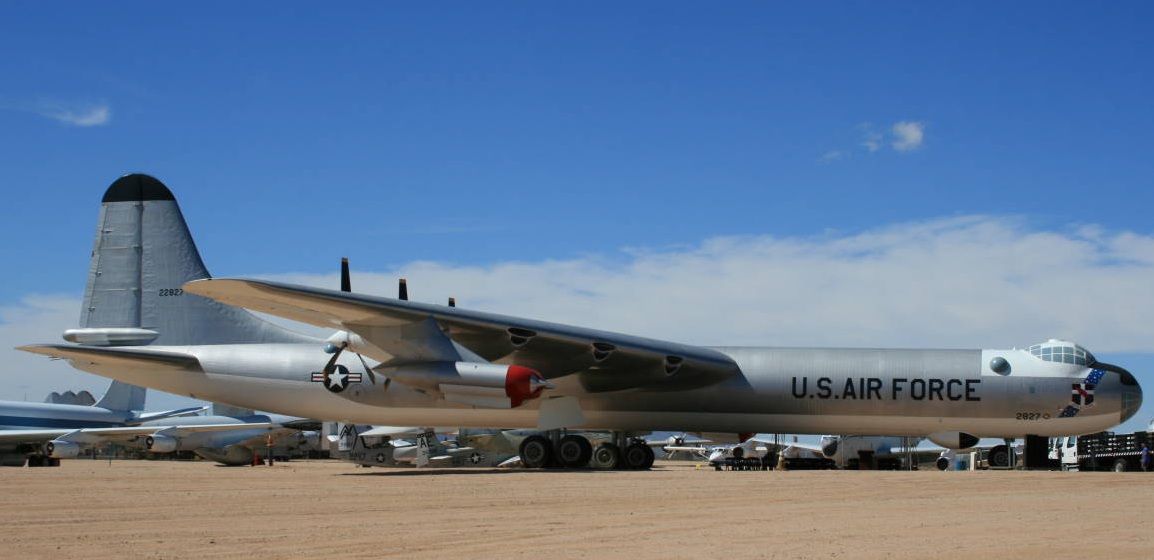
The B-36J Featherweight III had a cruise speed of 202 knots (232 miles per hour/374 kilometers per hour) and a maximum speed of 375 knots (432 miles per hour (695 kilometers per hour) at 38,000 feet (11,582 meters). The service ceiling was 43,700 feet (13,320 meters). It had a combat radius of 3,465 nautical miles (3,987 statute miles/6,417 kilometers) with a 10,000 pound (4,536 kilogram) bomb load. The maximum ferry range was 8,200 nautical miles (9,436 statute miles/15,186 kilometers).
The B-36J III had a maximum bomb load of 72,000 pounds (32,659 kilograms), carried in four bomb bays. The bomb bay capacity was limited by the physical size of each type weapon, rather than its weight. This ranged from as many as 132 500-pound bombs, 28 2,000-pound bombs, or 4 12,000-pound bombs. It could carry a single 43,600 pound (19,777 kilogram) T-12 Cloudmaker, a conventional explosive earth-penetrating bomb, or several nuclear fission or thermonuclear fusion bombs. By combining the bomb bays, one 41,400 pound (18,779 kilogram) Mk.17 15-megaton thermonuclear bomb could be carried.
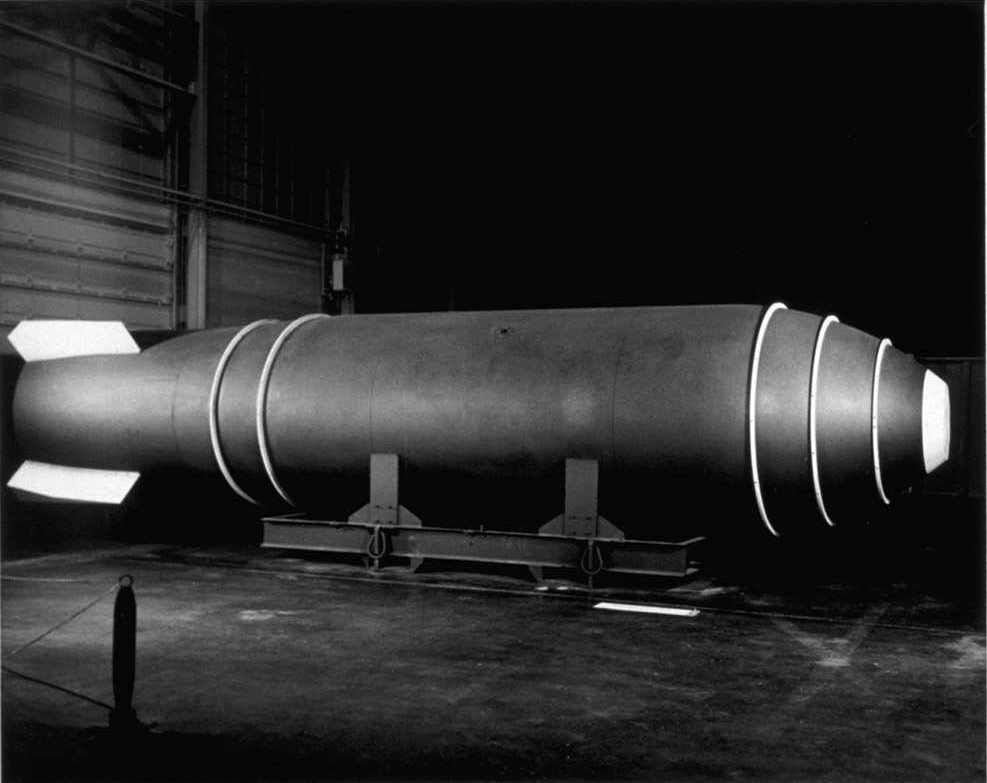
For defense, the B-36J Featherweight III two M24A1 20 mm autocannons in a remotely operated tail turret, with 600 rounds of ammunition per gun.
Between 1946 and 1954, 384 B-36 Peacemakers were built. They were never used in combat. Only five still exist.
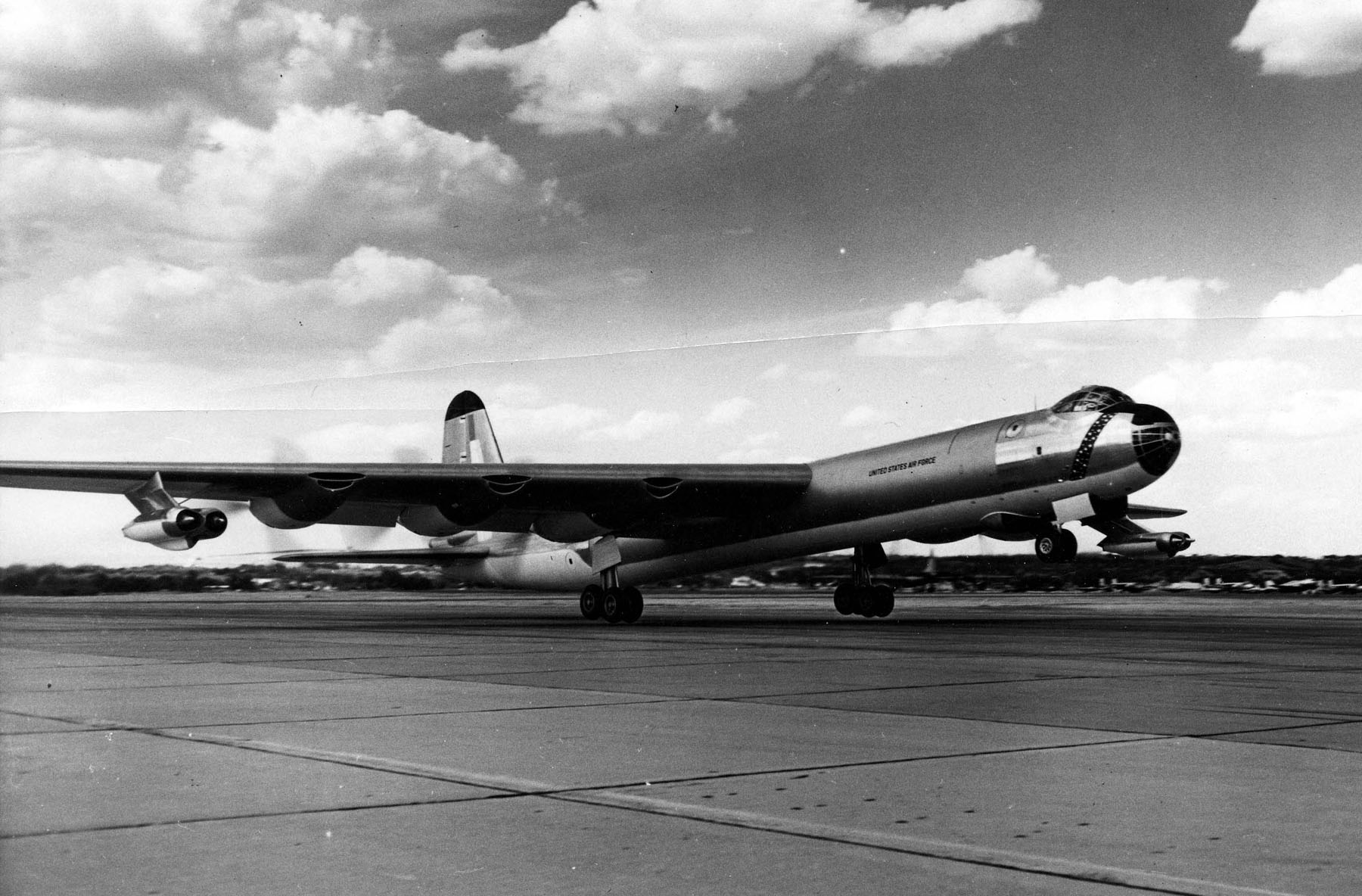
© 2018, Bryan R. Swopes
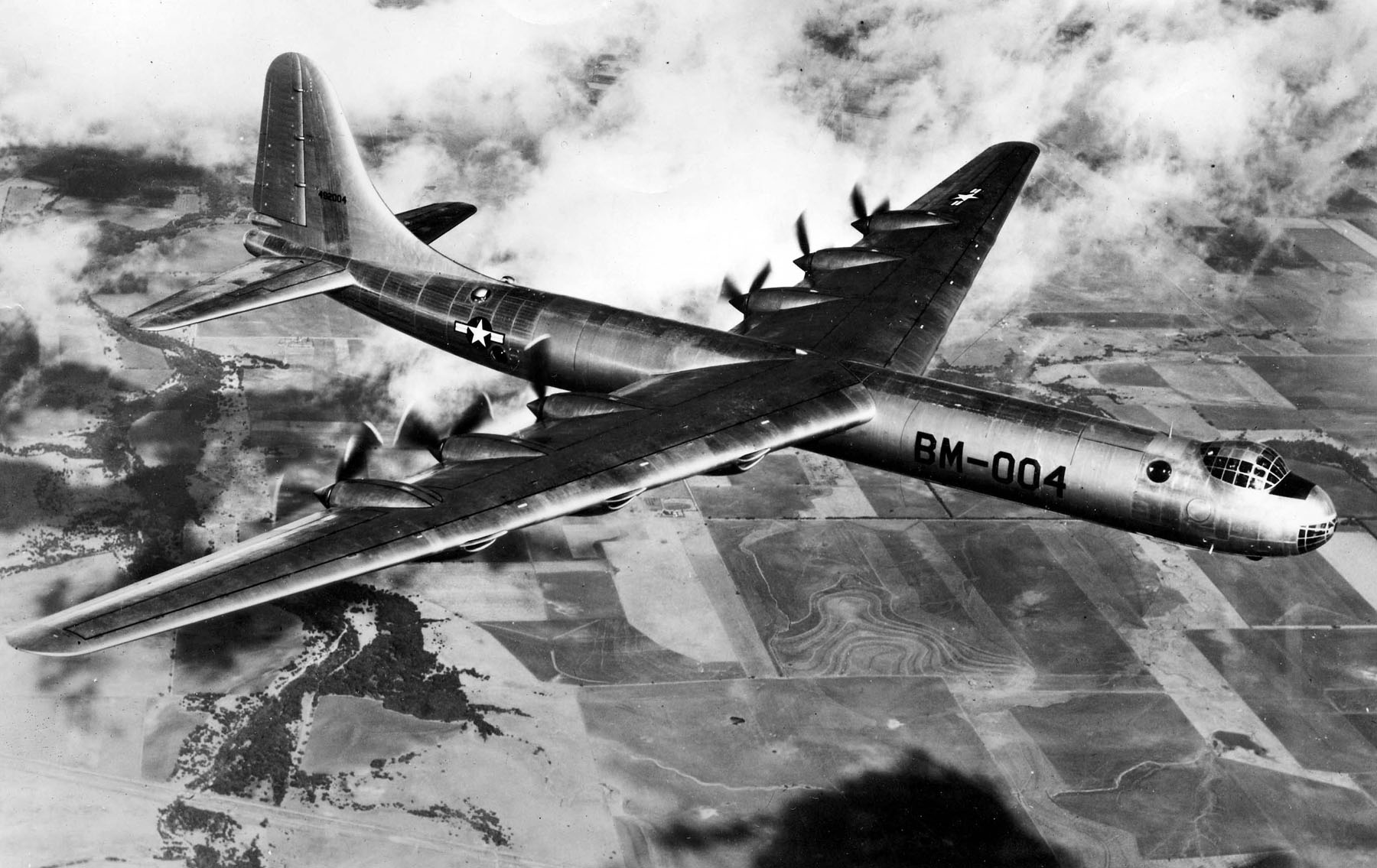
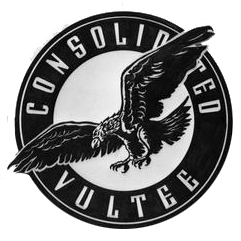 26 June 1948: The 7th Bombardment Wing, Very Heavy, at Carswell Air Force Base, Fort Worth, Texas, received the United States Air Force’s first Consolidated-Vultee Aircraft Corporation (“Convair”) B-36A, a six-engine, very long range heavy bomber. Its mission was to serve as a nuclear-capable deterrent until the Boeing B-52 Stratofortress came into service five years later. A total of 22 B-36As were delivered by February 1949. These were not armed and were used for crew training. Most were later converted by Convair to RB-36E reconnaissance bombers, beginning in 1950.
26 June 1948: The 7th Bombardment Wing, Very Heavy, at Carswell Air Force Base, Fort Worth, Texas, received the United States Air Force’s first Consolidated-Vultee Aircraft Corporation (“Convair”) B-36A, a six-engine, very long range heavy bomber. Its mission was to serve as a nuclear-capable deterrent until the Boeing B-52 Stratofortress came into service five years later. A total of 22 B-36As were delivered by February 1949. These were not armed and were used for crew training. Most were later converted by Convair to RB-36E reconnaissance bombers, beginning in 1950.
The B-36A differed from the XB-36 prototype in several areas, but two features were the most apparent: The cockpit had been completely revised and now covered by a large dome. The single-wheel main landing gear was replaced by four-wheel bogies to better spread the airplane’s weight over the runway surface.
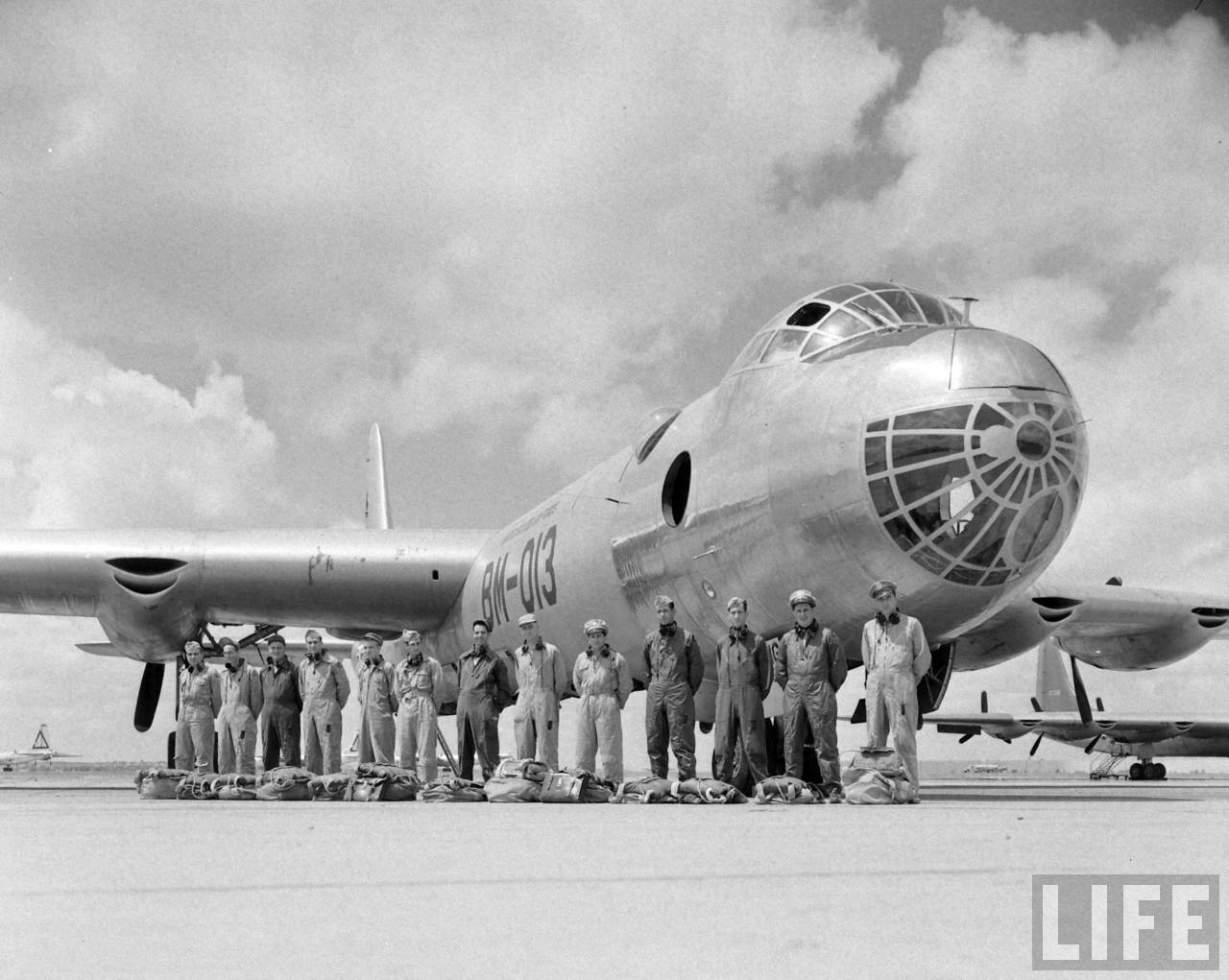
The B-36A was 162.1 feet (49.4 meters) long with a wingspan of 230.0 feet (70.1 meters) and overall height of 46.8 feet (14.3 meters). The wings had 2° dihedral, an angle of incidence of 3° and -2° twist. The wings’ leading edges were swept aft to 15° 5′. The airplane’s total wing area was 4,772 square feet (443.33 square meters). Its empty weight was 135,020 pounds (61,244 kilograms). The combat weight was 212,800 pounds (96,524 kilograms) and maximum takeoff weight (MTOW) was 310,380 pounds (140,786 kilograms).
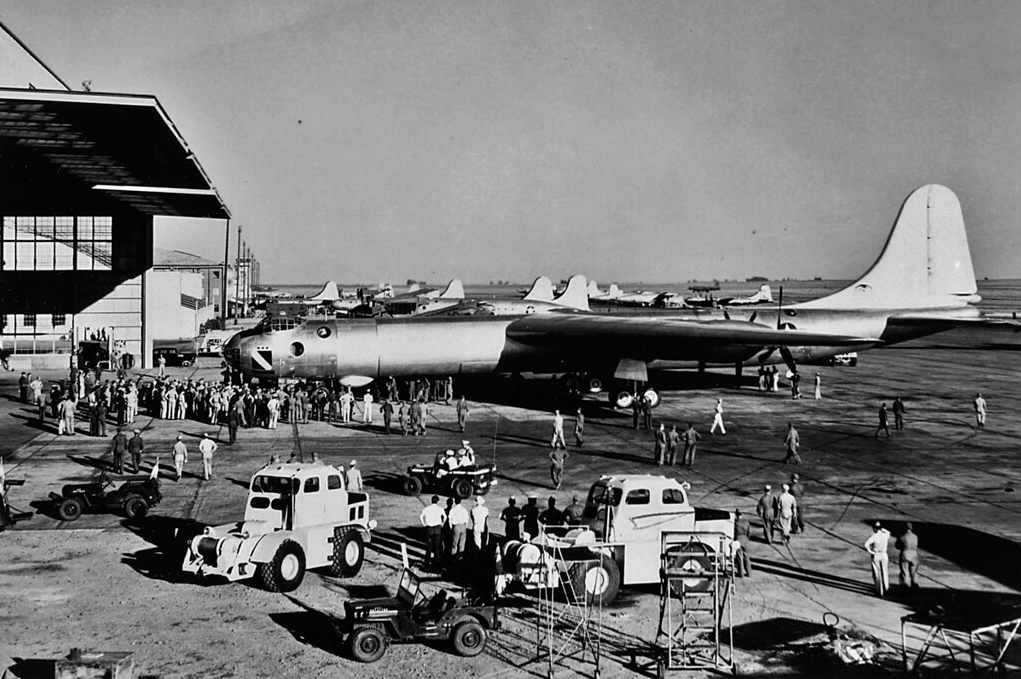
 The initial production version of the Peacemaker was powered by six air-cooled, supercharged, 4,362.5 cubic-inch-displacement (71.489 liter) Pratt & Whitney Wasp Major R-4360 Pusher (R-4360-25) four-row, 28-cylinder radial engines rated at 2,500 horsepower at 2,550 r.p.m. at 37,000 feet (11,278 meters), and 3,000 horsepower at 2,700 r.p.m. for takeoff. Each engine drove a 19-foot (5.791 meter) three-bladed propeller through a 0.381:1 gear reduction. The R-4360-25 was 9 feet, 1.75 inches (2.788 meters) long and 4 feet, 4.50 inches (1.334 meters) in diameter. It weighed 3,483 pounds (1,580 kilograms).
The initial production version of the Peacemaker was powered by six air-cooled, supercharged, 4,362.5 cubic-inch-displacement (71.489 liter) Pratt & Whitney Wasp Major R-4360 Pusher (R-4360-25) four-row, 28-cylinder radial engines rated at 2,500 horsepower at 2,550 r.p.m. at 37,000 feet (11,278 meters), and 3,000 horsepower at 2,700 r.p.m. for takeoff. Each engine drove a 19-foot (5.791 meter) three-bladed propeller through a 0.381:1 gear reduction. The R-4360-25 was 9 feet, 1.75 inches (2.788 meters) long and 4 feet, 4.50 inches (1.334 meters) in diameter. It weighed 3,483 pounds (1,580 kilograms).
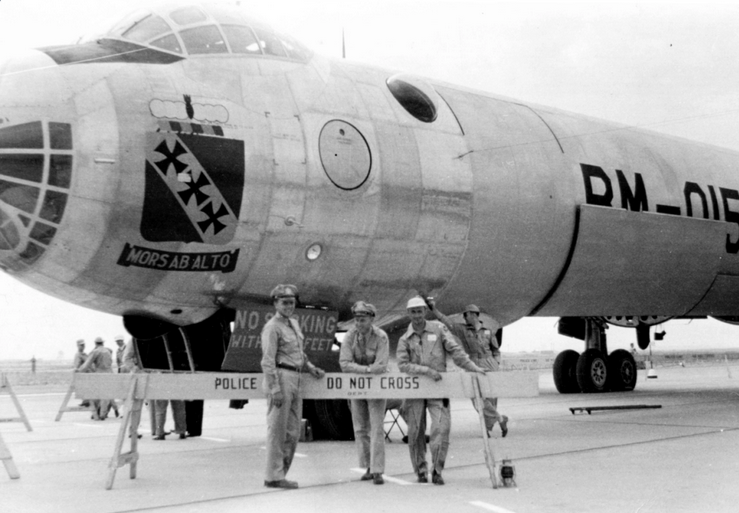
The six radial engines gave the bomber a maximum speed of 300 knots (345 miles per hour/556 kilometers per hour) at 31,600 feet (9,632 meters). It took 53 minutes for the giant airplane to climb to an altitude of 20,000 feet (6,396 meters). The service ceiling for the B-36A was 39,100 feet (11,918 meters), and combat ceiling was 35,800 feet (10,912 meters). The ferry range was 9,136 miles (14,702 kilometers).
The B-36As initially carried no defensive armament. The maximum bomb load was seventy-two 1,000 pound bombs (total, 72,000 pounds/32,659 kilograms) carried in four internal bomb bays. With a bomb load of 10,000 pounds (4,536 kilograms), the B-36A had a combat radius of 3,370 nautical miles (3,878 miles/6,241 kilometers).
Designed during World War II when nuclear weapons were unknown to aeronautical engineers, the bomber was designed to carry up to 86,000 pounds (39,009 kilograms) of conventional bombs. It could carry a single 43,600 pound (19,777 kilogram) T-12 Cloudmaker, a conventional explosive earth-penetrating bomb, or, later, several Mk.15 thermonuclear bombs. By combining the bomb bays, one Mk.17 15-megaton thermonuclear bomb could be carried.
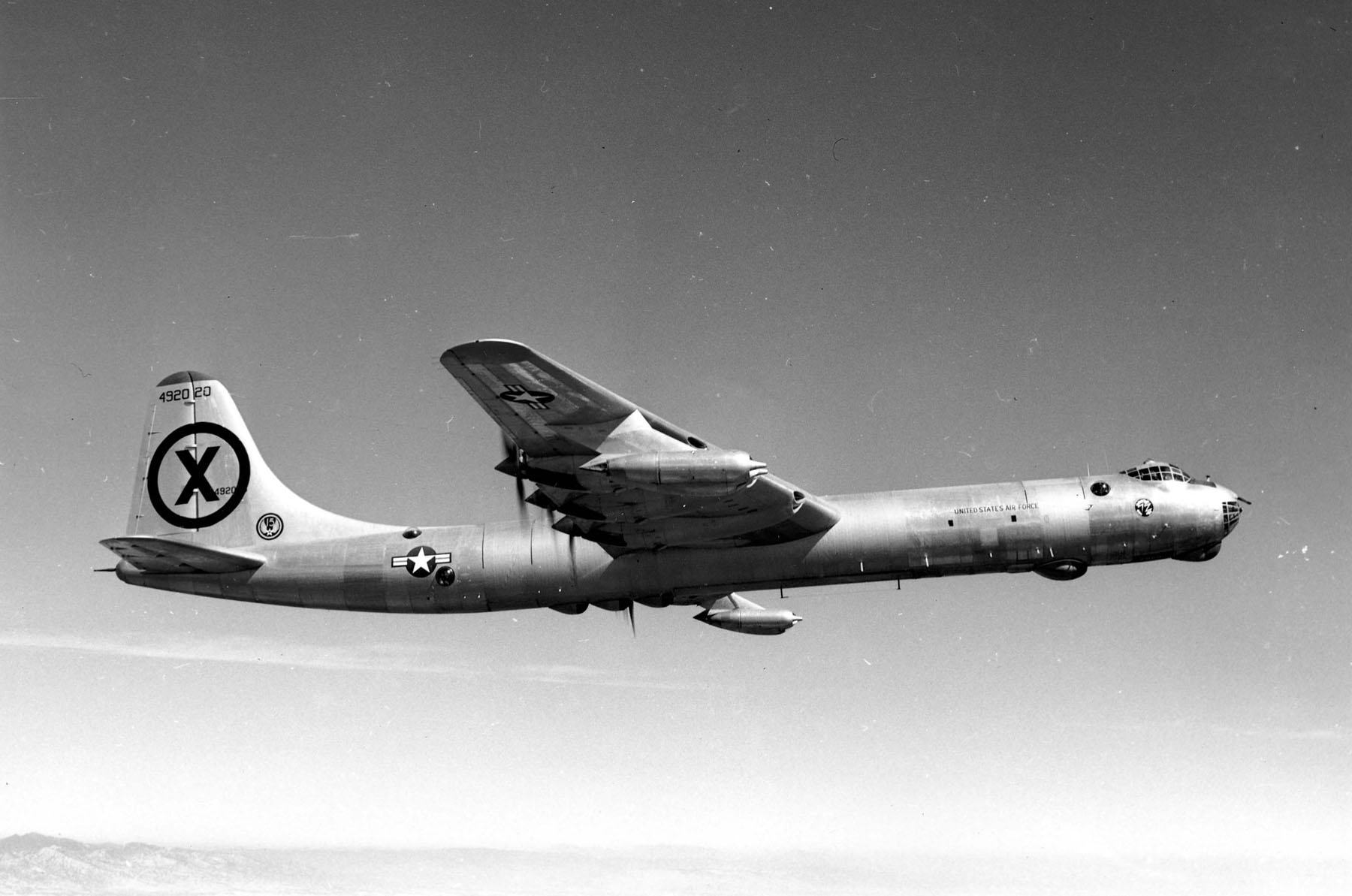
The RB-36E reconnaissance bomber carried a crew of 22. The radial engines were upgraded to R-4360-41s which increased takeoff horsepower with water injection to 3,500 at 2,700 r.p.m. at Sea Level. Four General Electric J47-GE-19 turbojet engines were added in two two-engine pods at the outer end of each wing. These changes significantly increased the airplane’s maximum speed and altitude capability and reduced the required takeoff distance by 25%. Fourteen reconnaissance cameras were installed. There were four additional radomes on the belly and numerous external antennas for electronic intelligence gathering.
The empty weight of the RB-36E increased to 164,238 pounds (74,497 kilograms) and the maximum takeoff weight to 370,000 pounds (167,829 kilograms).
The maximum speed of the RB-36E was 363 knots (418 miles per hour/672 miles per hour) at 38,200 feet (11,643 meters). Its service ceiling was 46,400 feet (14,143 meters).
The reconnaissance bomber carried eighty 188 pound (85.3 kilogram) T-56 photo flash bombs. Defensive armament consisted of sixteen M24A1 20 mm autocannon in five remotely-operated turrets. 9,200 rounds of ammunition were carried.
Between 1946 and 1954, 384 B-36 Peacemakers were built. They were never used in combat. Only five still exist.
The first Consolidated-Vultee B-36A, 44-92004, was flown to Wright Field, Dayton, Ohio, for structural testing. Redesignated YB-36A, it was tested to destruction.
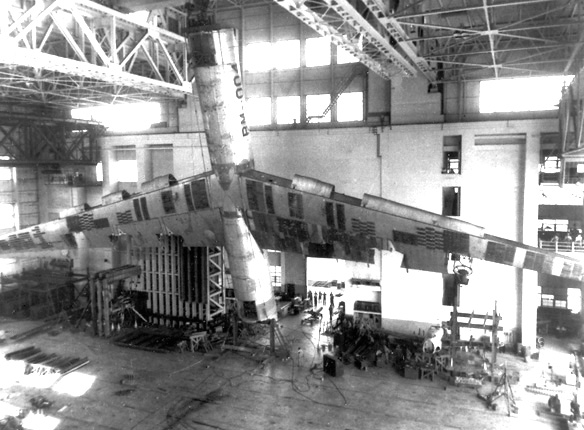
The name, “Peacemaker,” was suggested by a Convair employee. It is a reference to the Colt Model 1873 Single-Action Army® revolver, the classic “six-shooter” of the American frontier, which is also known as the Peacemaker®.
© 2018, Bryan R. Swopes